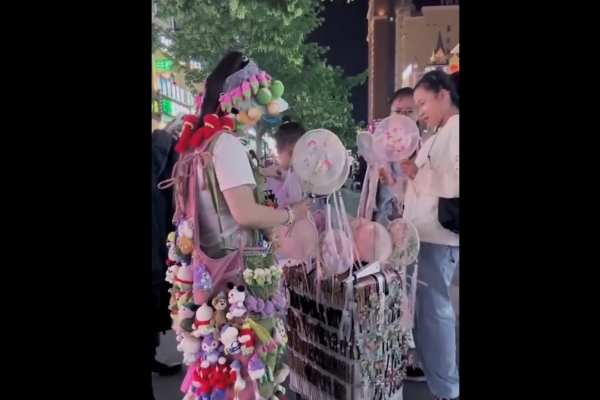This summer, starting from Dunhuang, Gansu to Sichuan and Chongqing, from Weihai, Shandong to Shangri-La, Yunnan, prices of guesthouses and hotels have dropped significantly, and travel agencies are finding it increasingly difficult to attract customers. Industry insiders point out that with the economic downturn and consumer downgrading, tourists are cutting costs wherever possible. The trend of “poor travel,” where travelers bring their own tents, cookware, and utensils, is becoming popular, leading to a consensus within the tourism industry that the peak season of summer 2025 is not booming as expected.
A post by the new media “Jing Travel Network” on Monday (July 21) quoted a tourism operator running a guesthouse in Weihai, Shandong, who said, “In previous summers, the room rates at our guesthouse always increased. However, this year, prices have plummeted from an average of 800 yuan per night to 400 yuan per night, yet we still have a large number of vacant rooms daily.”
The operator also mentioned that Weihai is a city with distinct peak and off-peak seasons for tourism. The tourism industry heavily relies on the three-month peak season of summer, and if the summer peak season proves to be disappointing, it will inevitably result in losses for the whole year.
Another tourism operator engaged in hotel franchising in the Sichuan and Chongqing region stated, “Many local attractions are experiencing significantly low visitor flow, with the phenomenon of long queues and crowded conditions disappearing. This has led to a drastic drop in hotel occupancy rates around the attractions, where a hotel achieving a 60% occupancy rate compared to the previous year is considered excellent.”
“If this operational situation persists throughout July, there will no longer be a peak season this summer,” and “the non-booming peak season of summer 2025” is gradually becoming a consensus in the tourism industry.
Recently, a post on Zhihu titled “Travel agencies facing a cliff-like decline, another industry being disrupted by the internet” quoted the owner of a travel agency lamenting, “Business is getting tougher. In previous summers, a single route could easily attract several tour groups, but now, it takes multiple travel agencies pooling resources to form one group.”
According to Morgan Stanley’s latest research data, during the first week of this summer (June 29 to July 5), the revenue per available room (RevPAR) of China’s hotels dropped by 8% year-on-year, with declining occupancy rates being the main influencing factor.
The article from “Jing Travel Network” stated that after conducting research in Dunhuang, the aforementioned operator found that many people are either sleeping in cars or setting up tents directly, camping at the edge of campgrounds or parking areas near attractions. Most independent travelers and self-driving tourists barely step foot in hotels, except for those on package tours like theirs.
Recently, there was a group of three individuals on Xiaohongshu who embarked on a self-driving tour from Chengdu to Qinghai and Gansu. They claimed to have covered 7,000 kilometers in Qinghai within 14 days, spending only 3,500 yuan per person by bringing their own tents, cookware, utensils, and even a tour guide license, saving on tickets and accommodation costs. Setting up tents for camping, converting a bread van into a makeshift bed, they enjoyed both the scenery and saved money along the way.
Ctrip’s car rental data predicts that domestic self-driving orders during the summer of 2025 are expected to increase by nearly 40% year-on-year, with outbound self-driving tours becoming more popular, potentially showing a 60% year-on-year increase in rental orders.
The article pointed out that behind the rise of domestic long-distance self-driving tours is the practical mindset of travelers. With economic constraints and thinner wallets, every penny saved counts.
According to the third-quarter 2024 national travel agency statistical survey report from the Ministry of Culture and Tourism of the People’s Republic of China, the number of organized domestic travel participants decreased by 38% year-on-year to 34.692 million in the third quarter of 2024. However, during the same period, the number of individual domestic travel service participants soared to 251 million, a 26.7% increase year-on-year.
This shows that travelers are no longer enthusiastic about packaged tours. Instead, they prefer to separate transportation, accommodation, tickets, and guides and organize their trips.
Since the epidemic, group tours organized by travel agencies have declined, giving way to the rapid rise of private group tours. However, this summer peak season, even the mode of private group tours is gradually being abandoned as more and more people opt for independent travel.
“Yibang Power” cited industry insiders predicting the annual shrinking of the summer peak season, “From fully booked for two months in the past to just one and a half months in the last two years. Looking at this year, it’s already late July, except for some popular attractions, most cities have not yet seen a peak in visitors, which is quite alarming.”
Additionally, the trend of “traveling while setting up stalls” is gaining popularity among young people in mainland China. Many young individuals are beginning to set up stalls in tourist destinations to earn money for their travels.
Blogger “Cheng Ge Views the World” analyzed in a post on Tuesday (22nd) that the trend of consumer downgrading due to economic pressure is evident. According to an online travel agency OTA survey, 62% of respondents mentioned they have “cut down on travel budgets,” with the proportion of choosing budget hotels rising to 45%. It is worth noting that the popularity of travel modes such as high-speed rail trips and camping are on the rise, reflecting consumers’ more rational decision-making patterns. The phenomenon of the tourism industry not booming during peak seasons may continue.

